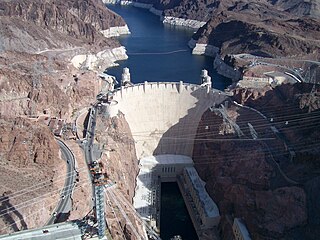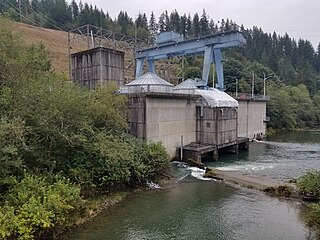
Tidal power or tidal energy is harnessed by converting energy from tides into useful forms of power, mainly electricity using various methods.

Rocky Reach Dam is a run-of-the-river hydroelectric dam in the U.S. state of Washington owned and operated by Chelan County Public Utility District. It has 11 generators rated in total 1300 MW. The project is on the Columbia River in north central Washington state about seven miles (11 km) upstream from the city of Wenatchee. The dam is 473 miles (761 km) above the mouth of the Columbia. The reservoir impounded by the dam is Lake Entiat. The project provides energy for more than 7 million people throughout the Pacific Northwest.

Rock Island Dam is a hydroelectric dam on the Columbia River, in the U.S. state of Washington. Chelan County Public Utility District's Rock Island Dam and Hydro Project was the first dam to span the Columbia, having been built from 1929 to 1933. It is located near the geographical center of Washington, about 12 miles (19 km) downstream from the city of Wenatchee. By river, the dam is 235 miles (378 km) south of the Canada–US border and 453 miles (729 km) above the mouth of the river at Astoria, Oregon. The dam's reservoir is called Rock Island Pool.

Wells Dam is a hydroelectric embankment dam located on the Columbia River, downstream from the confluence of the Okanogan River, Methow River, and the Columbia River in Washington state. The dam, associated structures, and machinery make up the Wells Hydroelectric Project. It is owned and operated by Douglas County Public Utility District.
The Chelan County Public Utility District, or Chelan County PUD, provides electric, water, wastewater public utility and telecommunications services in Chelan County, in north-central Washington, USA.
Energy Northwest is a public power joint operating agency in the northwest United States, formed 65 years ago in 1957 by Washington state law to produce at-cost power for Northwest utilities. Headquartered in the Tri-Cities at Richland, Washington, the WPPSS became commonly known as "Whoops!", due to over-commitment to nuclear power in the 1970s which brought about financial collapse and the second largest municipal bond default in U.S. history. WPPSS was renamed Energy Northwest in November 1998, and agency membership includes 28 public power utilities, including 23 of the state's 29 public utility districts.

According to preliminary data from the US Energy Information Administration, renewable energy accounted for about 12.6% of total primary energy consumption and about 19.8% of the domestically produced electricity in the United States in 2020.

Renewable energy in the United Kingdom contributes to production for electricity, heat, and transport.

The Culmback Dam is a large rockfill hydroelectric and water supply dam on the Sultan River, a tributary of the Skykomish River, in Washington. Built in 1965, the dam is 640 feet (200 m) long at the crest and 262 feet (80 m) high. Its reservoir, Spada Lake, provides water for 70 to 75 percent of Snohomish County and feeds the Jackson Hydro Project, providing 112 megawatts of clean energy to Snohomish county. Some critics charge that the dam has strongly impacted the runs of salmon and other migratory fish in the Sultan River by depleting gravel and sediment needed to line the riverbed. The dam's operator counters that Culmback Dam dramatically reduces flooding events, benefiting fish populations and the surrounding communities. The dam was named in honor of George Culmback, a former mayor of Everett.

Hydroelectricity is, as of 2019, the second-largest renewable source of energy in both generation and nominal capacity in the United States. In 2021, hydroelectric power produced 31.5% of the total renewable electricity, and 6.3% of the total U.S. electricity.

The electricity sector in Sri Lanka has a national grid which is primarily powered by hydroelectric power and thermal power, with sources such as photovoltaics and wind power in early stages of deployment. Although potential sites are being identified, other power sources such as geothermal, nuclear, solar thermal and wave power are not used in the power generation process for the national grid.

Renewable energy in Russia mainly consists of hydroelectric energy. In 2010, the country was the sixth largest producer of renewable energy in the world, although it was 56th when hydroelectric energy was not taken into account. Some 179 TWh of Russia's energy production came from renewable energy sources, out of a total economically feasible potential of 1823 TWh. 16% of Russia's electricity was generated from hydropower, and less than 1% was generated from all other renewable energy sources combined. Roughly 68% of Russia's electricity was generated from thermal power and 16% from nuclear power.
Energy Development Corporation is the largest producer of geothermal energy in the Philippines and the second largest in the world. It is involved in alternative energy projects, including geothermal, hydroelectric and wind energy projects. The company was formerly owned by the Philippine National Oil Company, a state corporation owned by the Republic of the Philippines engaged in the exploration of resources, production of energy and distribution of power supply to smaller electricity distributor. EDC was privatized and acquired by the Lopez Group as part of its energy and power supply utility business units.
Independent Power Producer (IPP) projects have had a significant presence in British Columbia since the 1980s. Their relationship with BC Hydro grew from the province's need to supply growing energy demands and implementation of the 2002 Energy Strategy, which mandated that BC Hydro would purchase its energy supply from IPPs rather than generating the supply itself. There are a variety of power projects in BC, with the most popular being hydroelectricity and biomass projects. In recent years, more attention has been placed on the environmental effects of IPP projects and the social implications it has to residents living around the project development sites. Despite the decline in demand for new IPP projects, in 2016 they supplied 20,000 GWh, one-third of BC Hydro's total.

Electricity in the Puget Sound region is a significant factor in people's lives, an enabler for the modern economy, and has a unique relationship with the region's environment.
California produces more renewable energy than any other state in the United States except Texas. In 2018, California ranked first in the nation as a producer of electricity from solar, geothermal, and biomass resources and fourth in the nation in conventional hydroelectric power generation. As of 2017, over half of the electricity (52.7%) produced was from renewable sources.

The Henry M. Jackson Hydroelectric Project, or Jackson Hydro Project, is an electric power generating project on the Sultan River operated and maintained by the Snohomish County Public Utility District in Washington, co-licensed by the city of Everett, Washington. Beginning operations in 1984, the project aims to bring clean and renewable hydropower to Snohomish county. The facility consists of a single powerhouse, two main generating units, a switch-yard, and transmission lines—all of which are directly connected to the county's local 115 kV power-transmission network. The largest generating station operated by the Snohomish county PUD, the Jackson Hydro powerhouse has a total nameplate capacity of 112 megawatts, enough to power 53,200 homes, and accounts for 7 percent of the Snohomish county PUD's total power needs. The vast remainder of the Snohomish county PUD's power comes from the Chief Joseph Dam, located in eastern Washington, through long-term contracts with the Bonneville Power Administration.












